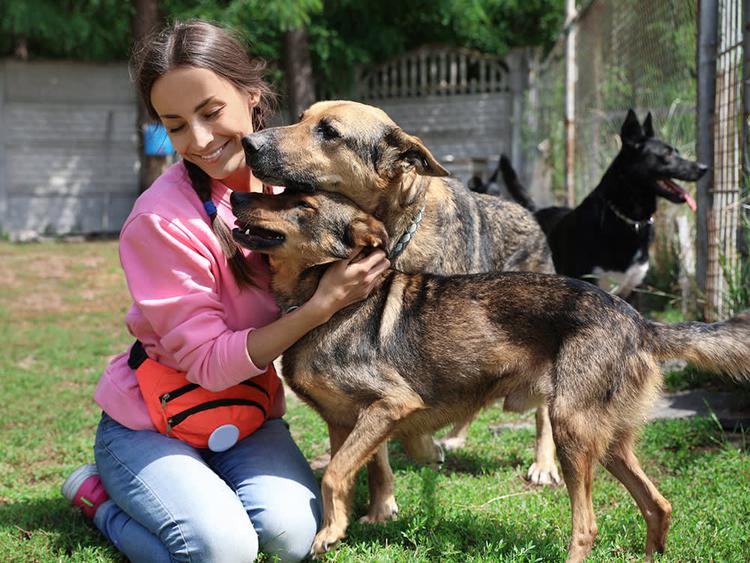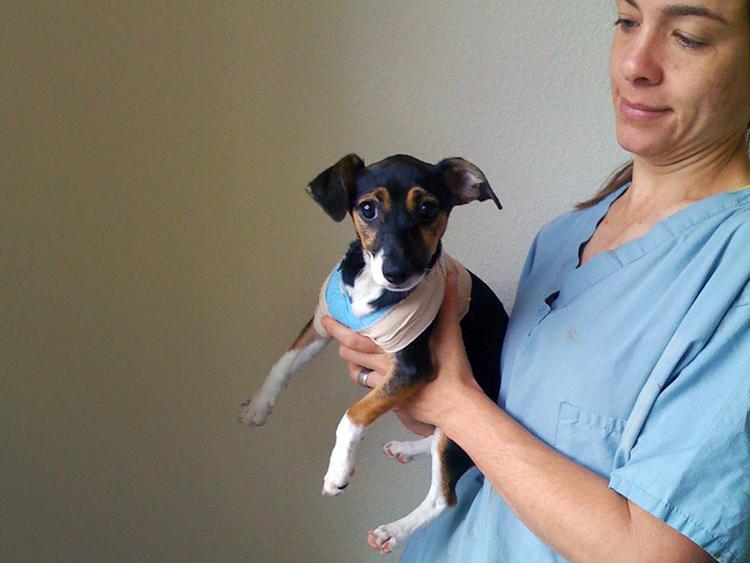It’s Adopt a Shelter Dog Month
Here’s how you can help a dog find a home this October.
Here’s how you can help a dog find a home this October.
by Janelle Leeson, | September 1, 2023

Demetr White / Stocksy
It’s officially Homecoming season. For some, that means finding time for football games, pep rallies, and school dances. But October 1 also marks the first day of one of the most important months for pups in need: Adopt a Shelter Dog Month. And we want every dog to have their own Homecoming.
In celebration of Adopt a Shelter Dog Month, Adopt a Pet and the PEDIGREE® brand have teamed up to find forever homes for dogs in need — and offer some serious winnings to you and your new bestie.
Whether you’re on the search for a star athlete, a dance date, or a snoozing senior who’ll keep you company while you refresh the game scores at home, Adopt a Pet can help you find the perfect pup to add to your family.
Share your adoption story with Adopt a Pet to receive a PEDIGREE® Wet Food Pouch as a welcome-home gift. You’ll also be entered to win a $4,000 donation to a shelter of your choice, a Wisdom Panel™ Premium dog DNA test, and a professional Homecoming-style photo shoot with your new pup. Three runners-up will get a $2,000 donation to a shelter of their choice, a Wisdom Panel™ Premium dog DNA test, and a PEDIGREE® starter kit full of treats and swag. Winners will be selected in mid-November — but be sure you adopt your pup during the month of October to be eligible.
Enter for a chance to be crowned the winner.
October is Adopt a Shelter Dog Month. Also known as Adopt-a-Dog Month by American Humane, the special month was created in 1981 to bring attention to the growing number of dogs and puppies entering shelters.
“This month gives people an opportunity to get excited about giving a homeless dog a second chance,” shares Nina Thompson, Director of Public Relations at the San Diego Humane Society. The organization is hoping to rev up adoption rates in October with special shelter events and reduced adoption fees.
While it’s important to give extra attention to shelter pups this month, they need our help all year round. According to the ASPCA, 3.1 million dogs enter U.S. animal shelters annually. But only two-thirds of them will be adopted.
Obviously, adopting a dog is the best way to support Adopt a Shelter Dog Month. That said, adoption isn’t the only way to support shelter dogs. According to Megan Newcomer, Marketing Coordinator at MaxFund Animal Adoption Center, there are big and small ways you can support beloved shelter dogs and the staff that keeps them safe, including:
Volunteering at a shelter or rescue organization
Donating to a shelter or rescue organization
Spreading awareness about dogs in need of their forever homes
Been contemplating getting a dog? Or maybe a buddy for your existing pup? Here are seven reasons why you (or a friend) should adopt a shelter dog.
Every year, just under a million companion animals are euthanized. This number is down from 2.6 million in 2011, and that progress comes courtesy of an increase in pet adoptions and the successful return of stray animals to their pet parents. As Thompson reminds us, each pet adopted makes room for another animal in need.
Shelters have dogs of all ages, breeds, and sizes, so you’re sure to find the perfect dog for your lifestyle and family. For instance, Thompson says the San Diego Humane Society currently has 363 dogs and 26 puppies available for adoption. Among their adoptable pups, you’ll find young dogs, old dogs, active canines, couch potatoes, and big and small furry friends in every breed and breed mix.
Adult and senior dogs have already developed their personalities, so you can feel more confident that they’ll be the right fit for your family and lifestyle. Thompson reminds those visiting the shelter to talk to staff and volunteers about a dog’s true personality.
“Dogs in shelters can be stressed and scared. The behavior of dogs in kennels and the shelter environment doesn’t often represent who they truly are and what they’ll be like in a home,” she says.
If you adopt a dog during October, many shelters and rescues reduce adoption fees in honor of Adopt a Shelter Dog Month. Regardless, you’ll certainly pay less at a shelter than you would if buying from a breeder. Did we mention that most shelter dogs are sent home microchipped, spayed or neutered, and vaccinated?
Staff and volunteers spend time getting to know each animal’s personality and needs, and they work with potential adopters to understand their lifestyles and preferences. If the dog you’re interested in is in foster care, you’ll get even better insights into what they’re like in a home environment.
In fact, some shelters offer an adoption guarantee, which means that if the adoption is not the right fit for you or the pet, you can bring them back to the shelter. “There is no shame in bringing them back. Just like when someone fosters a dog, we may learn information that will be beneficial in matching the pet with a new adopter,” Thompson says.
Shelters know that some pups may need extra time to adjust to their new home, so many offer services to help. The following are resources that may be available to you and your newly adopted pup.
Behavior helpline: Shelters may offer a behavior helpline where adopters can call to speak with an expert about any behavior or training concerns they notice as their pet settles in.
Training classes: Shelters may offer training classes for adopters and their new dogs, which can help dogs learn basic obedience cues and house rules.
Socialization events: Many shelters host socialization events where adopters and their dogs can meet other dogs and people in a safe, controlled environment.
Online resources: Shelters may have websites or social media pages with dog care and training resources.
“There is nothing stronger than the bond you create with a pet you rescued. They need you, and you quickly learn you need them,” Thompson explains.

Aleksey Boyko / Shutterstock
What if I can’t adopt a shelter dog? Support goes far beyond adopting a shelter dog, and includes the following.
Shelters and rescues always need fosters, who give pets temporary homes where they can socialize and safely heal from any injuries or illnesses. But especially after so many people bought or adopted dogs to keep them company during COVID-19, then surrendered them when it was time to return to work, the current need for fosters is dire.
“We’ve been over capacity every single day, and we know our colleagues across the country are experiencing the same capacity issues,” Thompson says.
Many shelters and rescues provide you with everything you need to foster, and you may be able to write off any pet supplies you do need to buy on your taxes.
Even if you can’t adopt or foster a pet, you can still make a difference by volunteering at a shelter. Shelters are always in need of volunteers to help with tasks like:
Walking dogs
Grooming and socializing animals
Folding laundry
Preparing food
Cleaning kennels
Thompson says that many shelters offer flexible hours and schedules, so you can volunteer on a schedule that works for you.
Newcomer stresses that every donation, no matter how big or small, can make a difference in the lives of many animals. Whether you donate money, food, supplies, or your time, your support can help save lives and provide animals with the care they need.
If you’re hesitant to donate money to a rescue, Thompson says there are a few ways to check their legitimacy.
Look for a Charity Navigator rating. Charity Navigator is a nonprofit organization that evaluates and rates other nonprofits based on their financial health, accountability, transparency, and impact. A high rating from Charity Navigator is a good sign that the organization is well-run and that your donation will be used effectively.
Check the organization’s website. Most legitimate organizations will post information about their intake, adoption rates, and financial data. You can look for information such as how many animals they serve each year, what percentage of their budget goes directly to programs, and how much money they spend on administrative costs.
Ask questions. If you have any questions about the organization or how your donation will be used, don’t hesitate to contact them. A reputable organization will be happy to answer your questions and provide you with more information.
Educate others about adopting dogs from shelters or rescues whenever you can. For example, if you see a cute picture of a pup you can’t personally adopt, share a link to their adoption profile on your social media feed. Thompson says this is especially important to prevent puppy mills from profiting.
Whether you’re a pet parent or a member of a pet-friendly community, you can do your part.
Spay or neuter your pet. Prevent accidental or unwanted litters by spaying and neutering your pets.
Microchip your pet. The biggest benefit of microchipping your pet is that it increases the chances of your pet being returned to you if they’re lost. If you find a lost pet, take them to your nearest veterinary clinic. They can scan them for a microchip and safely return them to their family.
Try to locate the family of a stray pet before bringing them to a shelter. Post on social media and community message boards, such as Facebook and Nextdoor, before taking stray pets to the shelter.
When you’re ready to adopt a shelter dog, you can visit Adopt a Pet to find available dogs in your area. You can also go directly to your local shelter or rescue organization’s website. Most shelters and rescues share adoption profiles on their websites, so you can browse through the dogs available for adoption and learn more about their personalities and any special needs.
“There are also bigger sites that pull adoption profiles from multiple shelters and rescues based on your area,” Thompson explains.
You can also try adopting directly from a pet parent facing the tough decision to give up their pet. This means keeping more room open in shelters. Sites such as Adopt a Pet will also feature folks looking to rehome their pets.

Janelle Leeson is a Portland, Oregon-based freelance writer. Her work has been featured in magazines such as Inside Your Dog’s Mind, Inside Your Cat’s Mind, and Paw Print, as well online at Insider Reviews, NBC Select, Shop Today, PetMD, and Daily Paws. She has two adventure cats, a flock of urban chickens, and a soon-to-be-husband who doesn’t mind housing the occasional foster cat — or five.

Adoption Advice

Adoption Advice

Shelters & Rescue

Adoption Advice
Learn the many benefits of adopting a shelter dog, and why giving a dog a second chance at a home is truly rewarding.

Shelters & Rescue

Adoption Advice
The right timing can make all the difference in your puppy’s growth and behavior.

Breed Info
There’s an outsize number of homeless pups South of the border. Here’s how some organizations are making a difference — and how you can help.

Adoption Advice
Unfortunately, the term “adopt, don’t shop” exists for a reason, because buying a puppy can unwittingly come with a host of problems.

Shelters & Rescue
What pet parents should know about adopting a parvo puppy.